Patients the Focus of Radiologists at RSNA 2012
|
By Dan Gueron Posted on 24 Dec 2012 |
The Radiological Society of North America’s (Oak Brook, IL, USA) 98th scientific assembly and annual meeting (RSNA 2012) highlighted the best in radiologic education and research and the world’s largest technical exhibit floor space for medical imaging technology.
RSNA 2012, which was held in McCormick Place, Chicago (IL, USA) on November 25-30, 2012, emphasized RSNA’s ongoing focus on improving patient care through radiology education and research. “The RSNA annual meeting is the world’s premier scientific and educational forum in radiology, bringing together more radiology and medical imaging professionals than any other venue,” said RSNA executive director, Mark Watson.
Professional attendees could choose during the meeting from 1,863 scientific presentations, 235 refresher courses, 86 multisession courses, 40 series courses, 45 informatics courses, 2,111 education exhibits and 1,257 scientific posters, as well as many special lectures. Technical exhibits at RSNA 2012 filled three buildings of McCormick Place, with 649 exhibits in 444,900 square feet of space, including 90 first-time exhibitors.
Official registration figures for RSNA 2012 reported total attendance at 53,778, including 26,154 professional attendees, 21,288 exhibitors, and 6,336 attendees classified as “guest” or “other.” Of the professional attendees, 36% were from outside North America. Exhibitor attendance and professional numbers were on same level as with earlier years.
The RSNA 2012 Virtual Meeting attracted more than 6,000 attendees from 107 countries and provided access to nearly 50 scientific and education sessions and courses. “RSNA 2012 was very successful,” Mr. Watson said. “As a consequence of the uncertain global economic climate, we anticipated a decrease in overall attendance. However, professional and exhibitor attendance remained strong, and RSNA member attendance increased over that of 2011.”
RSNA is an association of more than 51,000 radiologists, radiation oncologists, medical physicists, and related scientists, encouraging excellence in patient care and healthcare delivery through research, education, and technologic advanced.
Related Links:
Radiological Society of North America
RSNA 2012, which was held in McCormick Place, Chicago (IL, USA) on November 25-30, 2012, emphasized RSNA’s ongoing focus on improving patient care through radiology education and research. “The RSNA annual meeting is the world’s premier scientific and educational forum in radiology, bringing together more radiology and medical imaging professionals than any other venue,” said RSNA executive director, Mark Watson.
Professional attendees could choose during the meeting from 1,863 scientific presentations, 235 refresher courses, 86 multisession courses, 40 series courses, 45 informatics courses, 2,111 education exhibits and 1,257 scientific posters, as well as many special lectures. Technical exhibits at RSNA 2012 filled three buildings of McCormick Place, with 649 exhibits in 444,900 square feet of space, including 90 first-time exhibitors.
Official registration figures for RSNA 2012 reported total attendance at 53,778, including 26,154 professional attendees, 21,288 exhibitors, and 6,336 attendees classified as “guest” or “other.” Of the professional attendees, 36% were from outside North America. Exhibitor attendance and professional numbers were on same level as with earlier years.
The RSNA 2012 Virtual Meeting attracted more than 6,000 attendees from 107 countries and provided access to nearly 50 scientific and education sessions and courses. “RSNA 2012 was very successful,” Mr. Watson said. “As a consequence of the uncertain global economic climate, we anticipated a decrease in overall attendance. However, professional and exhibitor attendance remained strong, and RSNA member attendance increased over that of 2011.”
RSNA is an association of more than 51,000 radiologists, radiation oncologists, medical physicists, and related scientists, encouraging excellence in patient care and healthcare delivery through research, education, and technologic advanced.
Related Links:
Radiological Society of North America
Latest General/Advanced Imaging News
- New Ultrasmall, Light-Sensitive Nanoparticles Could Serve as Contrast Agents
- AI Algorithm Accurately Predicts Pancreatic Cancer Metastasis Using Routine CT Images
- Cutting-Edge Angio-CT Solution Offers New Therapeutic Possibilities
- Extending CT Imaging Detects Hidden Blood Clots in Stroke Patients
- Groundbreaking AI Model Accurately Segments Liver Tumors from CT Scans
- New CT-Based Indicator Helps Predict Life-Threatening Postpartum Bleeding Cases
- CT Colonography Beats Stool DNA Testing for Colon Cancer Screening
- First-Of-Its-Kind Wearable Device Offers Revolutionary Alternative to CT Scans
- AI-Based CT Scan Analysis Predicts Early-Stage Kidney Damage Due to Cancer Treatments
- CT-Based Deep Learning-Driven Tool to Enhance Liver Cancer Diagnosis
- AI-Powered Imaging System Improves Lung Cancer Diagnosis
- AI Model Significantly Enhances Low-Dose CT Capabilities
- Ultra-Low Dose CT Aids Pneumonia Diagnosis in Immunocompromised Patients
- AI Reduces CT Lung Cancer Screening Workload by Almost 80%
- Cutting-Edge Technology Combines Light and Sound for Real-Time Stroke Monitoring
- AI System Detects Subtle Changes in Series of Medical Images Over Time
Channels
Radiography
view channel
AI Algorithm Uses Mammograms to Accurately Predict Cardiovascular Risk in Women
Cardiovascular disease remains the leading cause of death in women worldwide, responsible for about nine million deaths annually. Despite this burden, symptoms and risk factors are often under-recognized... Read more
AI Hybrid Strategy Improves Mammogram Interpretation
Breast cancer screening programs rely heavily on radiologists interpreting mammograms, a process that is time-intensive and subject to errors. While artificial intelligence (AI) models have shown strong... Read moreMRI
view channel
AI-Assisted Model Enhances MRI Heart Scans
A cardiac MRI can reveal critical information about the heart’s function and any abnormalities, but traditional scans take 30 to 90 minutes and often suffer from poor image quality due to patient movement.... Read more
AI Model Outperforms Doctors at Identifying Patients Most At-Risk of Cardiac Arrest
Hypertrophic cardiomyopathy is one of the most common inherited heart conditions and a leading cause of sudden cardiac death in young individuals and athletes. While many patients live normal lives, some... Read moreUltrasound
view channel
Disposable Ultrasound Patch Performs Better Than Existing Devices
Wearable ultrasound devices are widely used in diagnostics, rehabilitation monitoring, and telemedicine, yet most existing models rely on lead-based piezoelectric ceramics that pose health and environmental risks.... Read more
Non-Invasive Ultrasound-Based Tool Accurately Detects Infant Meningitis
Meningitis, an inflammation of the membranes surrounding the brain and spinal cord, can be fatal in infants if not diagnosed and treated early. Even when treated, it may leave lasting damage, such as cognitive... Read moreNuclear Medicine
view channel
PET Tracer Enables Same-Day Imaging of Triple-Negative Breast and Urothelial Cancers
Triple-negative breast cancer (TNBC) and urothelial bladder carcinoma (UBC) are aggressive cancers often diagnosed at advanced stages, leaving limited time for effective treatment decisions.... Read more
New Camera Sees Inside Human Body for Enhanced Scanning and Diagnosis
Nuclear medicine scans like single-photon emission computed tomography (SPECT) allow doctors to observe heart function, track blood flow, and detect hidden diseases. However, current detectors are either... Read more
Novel Bacteria-Specific PET Imaging Approach Detects Hard-To-Diagnose Lung Infections
Mycobacteroides abscessus is a rapidly growing mycobacteria that primarily affects immunocompromised patients and those with underlying lung diseases, such as cystic fibrosis or chronic obstructive pulmonary... Read moreImaging IT
view channel
New Google Cloud Medical Imaging Suite Makes Imaging Healthcare Data More Accessible
Medical imaging is a critical tool used to diagnose patients, and there are billions of medical images scanned globally each year. Imaging data accounts for about 90% of all healthcare data1 and, until... Read more
Global AI in Medical Diagnostics Market to Be Driven by Demand for Image Recognition in Radiology
The global artificial intelligence (AI) in medical diagnostics market is expanding with early disease detection being one of its key applications and image recognition becoming a compelling consumer proposition... Read moreIndustry News
view channel
GE HealthCare and NVIDIA Collaboration to Reimagine Diagnostic Imaging
GE HealthCare (Chicago, IL, USA) has entered into a collaboration with NVIDIA (Santa Clara, CA, USA), expanding the existing relationship between the two companies to focus on pioneering innovation in... Read more
Patient-Specific 3D-Printed Phantoms Transform CT Imaging
New research has highlighted how anatomically precise, patient-specific 3D-printed phantoms are proving to be scalable, cost-effective, and efficient tools in the development of new CT scan algorithms... Read more
Siemens and Sectra Collaborate on Enhancing Radiology Workflows
Siemens Healthineers (Forchheim, Germany) and Sectra (Linköping, Sweden) have entered into a collaboration aimed at enhancing radiologists' diagnostic capabilities and, in turn, improving patient care... Read more




















